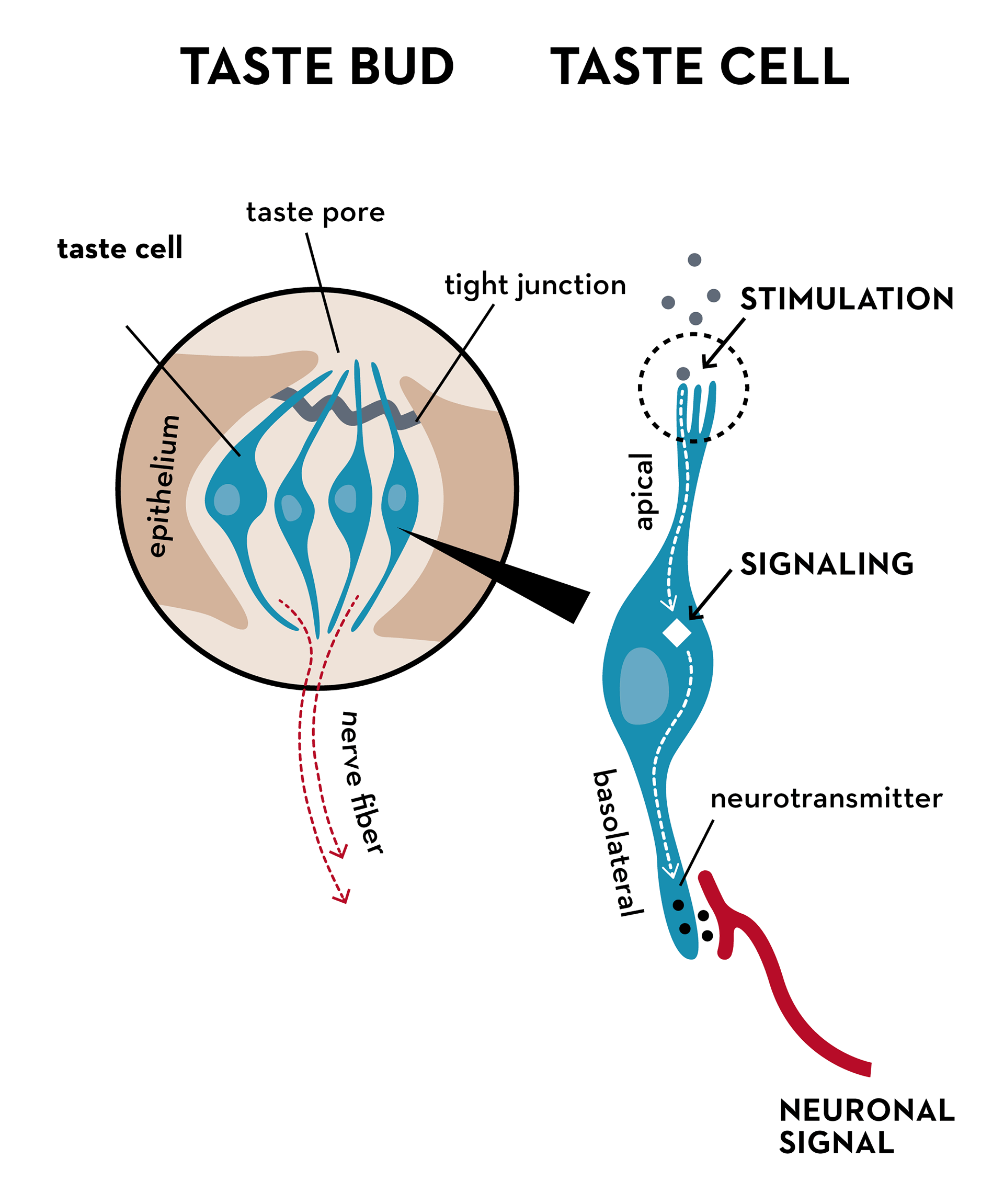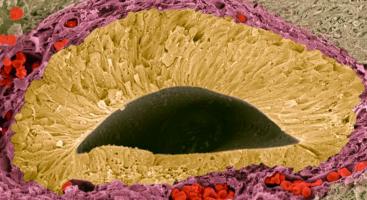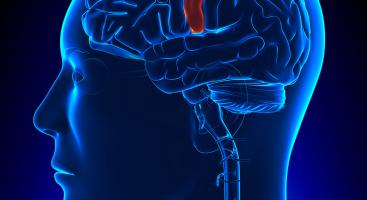Sensing what we eat
The body is capable of making nuanced distinctions between nutritious and harmful substances. Our taste receptors, located in different parts of the body, aren’t easy to fool.
Swallow or reject – the "in-mouth" moment of nutrition
The evaluation in the oral cavity of food sensory attributes such as taste, texture, temperature and aroma enables us to avoid potentially harmful or toxic compounds and to select among foods rich in nutrients to meet our energy needs. Taste, an essential sense in the selection of nutrients, is the special detection of chemicals eliciting the sensation of sweet, sour, salty, bitter, umami and perhaps fat. All other sensations that we tend to call taste in everyday language, such as peach, vanilla, and chocolate are actually aromatic experiences caused by volatile molecules travelling through the back of the mouth to the nose during chewing. Sweet taste comes from sugars, food rich in energy needed for all metabolic activity of the body; “salty” characterizes food rich in sodium, essential for different physiological activities such as nervous system function and the control of body fluid volumes; “umami” is associated with detecting foods rich in amino acids, the building blocks of proteins essential for the renewal of our cells and hormonal regulation of body function; “sour” and “bitter” often describe rotten or poisonous food, respectively. The detection of fat, the most energy-dense nutrient, relies primarily on texture, although taste also plays a role.
Foodborne molecules that create taste are dissolved in the saliva and come into contact with mini-organs called taste buds covering the taste papillae on the tongue and the soft palate. Taste buds are made of about 100 specialized taste receptor cells projecting microvilli (tiny hair-like membranes) through a pore in the lingual epithelium (tongue surface) to make contact with saliva and its content. On the opposite basal side, taste buds are in contact with taste nerves, which send signals to the brain. The first response induced by the stimulation of these nerves is the taste sensation, which makes us decide to swallow or reject the proposed food. Molecular receptors able to detect sweet, umami, and bitter molecules are well known whereas the mechanisms of salty, sour and fatty compound detection are not yet fully understood. Taste is “hard-wired”. From the moment of birth on, we humans prefer sweet food and reject bitter compounds. Understanding sweet, salt and fat taste perception is important because they are more than flavours, they are also major drivers of food preference and are often over-consumed.
Beyond the tongue: Tasting through body and brain
A fascinating aspect of taste receptors is the recent discovery that they are found not only on the surface of the tongue, where they were initially discovered, but also in the gastrointestinal tract and in some other organs. It appears that those receptors monitor the nutrient content of a number of organs to adapt the physiological function of the organ to the nature of its content. The precise physiological roles of the taste receptors beyond the tongue are still being worked out. We know that sweet taste receptors are found throughout the gastrointestinal tract, contributing to the modulation of glucose absorption. This receptor is activated by the presence of high amounts of glucose in the intestine, leading to increased density and activity of the intestinal glucose transporters and ultimately to faster intestinal glucose absorption. In animal models, activation of the sweet taste receptor induces the secretion of GLP-1, a hormone that stimulates insulin secretion, but a similar effect has not been clearly documented in humans.
The liking of nutrients, especially sugar and fat, and dislike of toxins, occur not only through taste, but also, interestingly through after-effects of ingestion (absorbing food). It is well known that if ingestion of a liked flavour is paired with a noxious stimulus such as illness or pain, subsequent exposures to this flavour will be disliked. This phenomenon might contribute to the anorexia that develops following chemotherapy in cancer patients. Inversely, if a neutral flavour is paired with infusion of a nutritious substance such as carbohydrate or fat into the stomach, liking of the flavour is increased during subsequent exposures. While clearly documented in animals, the extent to which flavour-nutrient learning contributes to our learned liking of food is still unclear.
It is tempting to speculate that gut-expressed taste receptors mediate learned preference and avoidance. There is anecdotal evidence that the bitter taste receptors may contribute to learned aversion. The sweet taste receptor has been ruled out as mediator of learned preference related to the ingestion of sugars. Recent data in mice show that fatty acid receptors contribute to learned preference associated with ingestion of fat. Clearly, there are many mechanisms by which nutritious food is identified as such, taste being only one of them. It is very difficult to fool our body into believing that a non-caloric food is actually nutritious. For example, artificial sweeteners taste sweet like sugars, but brain imaging studies have shown that the brain is capable of distinguishing them, and is more satisfied with sugars. How the brain manages to do this is unclear.
Spices – pleasure and pain: Sensory attacks and defences
Beside taste perception, the trigeminal system of nerves around the face plays a key role in the evaluation of flavour and food attributes in the mouth, and especially in the detection of sensations produced by spices. Trigeminal perception refers to the in-mouth detection of chemical compounds that produces sensations called chemesthetic related to touch, pain and temperature and responsible for in-mouth sensations such as astringency, texture, cooling, tingling, anaesthetic feeling, pungency or spiciness. Since the sensory mechanism involved in noxious hot/cold temperature is the same mechanism as chemesthesis, consuming herbs or spices often arouses sensations like the long-lasting burning produced by chilli pepper, the cooling feeling on the breath after a minty candy or the strange numbing sensation from Sichuan pepper. These sensations are transmitted to the brain by the trigeminal nerve that runs into the oral cavity as well as the skin of the face, the nasal cavity and part of the eye. That is why some of these sensations can be perceived on the skin, in the nose or in the eye such as the irritation produced by chilli pepper accidentally getting into the eyes during cooking.
Most spicy ingredients or their source plants are toxic if swallowed in large quantities. Trigeminal somatosensory stimulation (stimulation outside direct sensory organs) acts as a mechanism of protection against the further ingestion of such ingredients by inducing painful alert signals or coughing. As with taste receptors, it has been shown that receptors involved in the sensing of spices are expressed in the gastrointestinal tract and other organs and are reacting to various stimuli such as temperature, chemicals or inflammatory molecules. Compared to taste receptors, spice receptors expressed in the gastrointestinal tract are not involved in nutrient sensing but they are part of a protection mechanism against environmental stress. As an example, some spicy molecules (e.g. mustard) are able to modify gut motility to decrease transit time. It could be postulated that this mechanism would help to get rid of potentially toxic compounds ingested by mistake. Even if the reaction of the organism to sensory signals triggered by spicy ingredients might prevent their consumption, eating them is associated with many beneficial effects, especially in traditional medicine.
As described here, mechanisms involved in perception of food sensory attributes are not just involved in the enjoyable aspect of food but also in the detection of its nutritional or noxious values, and accordingly in the adaptation of metabolic or behavioural functions.










